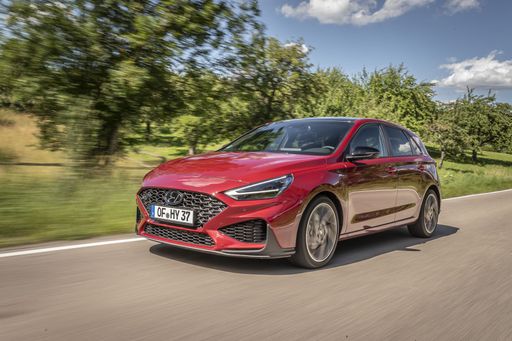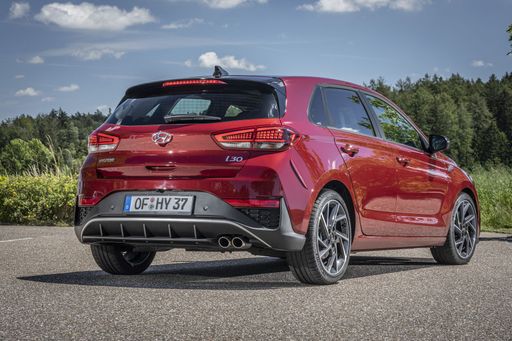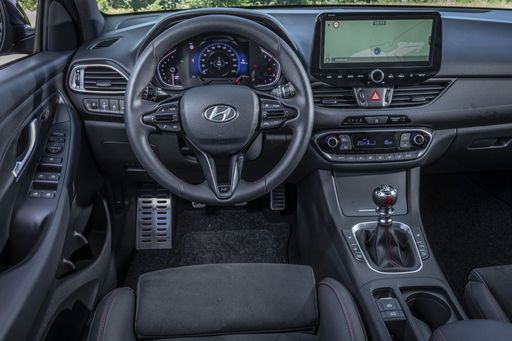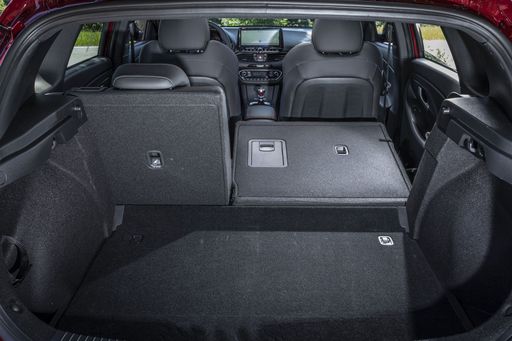Hyundai i30 vs Mercedes Marco Polo – Differences & prices compared
Compare performance, boot space, consumption and price in one view.
Find out now: which car is the better choice for you – Hyundai i30 or Mercedes Marco Polo?
The Hyundai i30 (Hatchback) comes with a Petrol or Petrol MHEV engine and Manuel or Automatic transmission. In comparison, the Mercedes Marco Polo (Bus) features a Diesel engine with Automatic transmission.
When it comes to boot capacity, the Hyundai i30 offers 395 L, while the Mercedes Marco Polo provides 670 L – depending on how much space you need. If you’re looking for more power, decide whether the 140 HP of the Hyundai i30 or the 237 HP of the Mercedes Marco Polo suits your needs better.
In terms of consumption, the values are 5.70 L per 100 km for the Hyundai i30, and 7.60 L for the Mercedes Marco Polo.
Price-wise, the Hyundai i30 starts at 24000 £, while the Mercedes Marco Polo is available from 62500 £. Compare all the details and find out which model fits your lifestyle best!
Hyundai i30
The Hyundai i30 stands out in the hatchback segment with its sleek design and modern features. It offers a comfortable ride with a well-crafted interior that caters to both driver and passengers. With its emphasis on safety and technology, the i30 provides a balanced driving experience suitable for urban and suburban environments.
details @ hyundai.news
@ hyundai.news
 @ hyundai.news
@ hyundai.news
 @ hyundai.news
@ hyundai.news
 @ hyundai.news
@ hyundai.news
 @ hyundai.news
@ hyundai.news
Mercedes Marco Polo
The Mercedes-Benz Marco Polo offers a luxurious and versatile travel experience, combining high-end design with practical functionality. Its spacious interior is thoughtfully designed, providing ample comfort for long journeys, while innovative features enhance the overall driving experience. This vehicle seamlessly integrates style with adventure, making it an ideal choice for those looking to explore the open road in comfort and sophistication.
details

|
|
|
|
|
Costs and Consumption |
|
|---|---|
|
Price
24000 - 29300 £
|
Price
62500 - 76700 £
|
|
Consumption L/100km
5.7 - 6 L
|
Consumption L/100km
7.6 - 8.3 L
|
|
Consumption kWh/100km
-
|
Consumption kWh/100km
-
|
|
Electric Range
-
|
Electric Range
-
|
|
Battery Capacity
-
|
Battery Capacity
-
|
|
co2
130 - 136 g/km
|
co2
199 - 218 g/km
|
|
Fuel tank capacity
50 L
|
Fuel tank capacity
70 L
|
Dimensions and Body |
|
|---|---|
|
Body Type
Hatchback
|
Body Type
Bus
|
|
Seats
5
|
Seats
4
|
|
Doors
5
|
Doors
4
|
|
Curb weight
1291 - 1407 kg
|
Curb weight
2531 - 2545 kg
|
|
Trunk capacity
395 L
|
Trunk capacity
670 L
|
|
Length
4340 mm
|
Length
5140 mm
|
|
Width
1795 mm
|
Width
1928 mm
|
|
Height
1455 mm
|
Height
1975 mm
|
|
Payload
463 - 509 kg
|
Payload
555 - 569 kg
|
Engine and Performance |
|
|---|---|
|
Engine Type
Petrol, Petrol MHEV
|
Engine Type
Diesel
|
|
Transmission
Manuel, Automatic
|
Transmission
Automatic
|
|
Transmission Detail
Manual Gearbox, Dual-Clutch Automatic
|
Transmission Detail
Automatic Gearbox
|
|
Drive Type
Front-Wheel Drive
|
Drive Type
All-Wheel Drive, Rear-Wheel Drive
|
|
Power HP
100 - 140 HP
|
Power HP
163 - 237 HP
|
|
Acceleration 0-100km/h
9.6 - 13.1 s
|
Acceleration 0-100km/h
7.4 - 10.7 s
|
|
Max Speed
178 - 197 km/h
|
Max Speed
188 - 220 km/h
|
|
Torque
172 - 253 Nm
|
Torque
380 - 500 Nm
|
|
Number of Cylinders
3 - 4
|
Number of Cylinders
4
|
|
Power kW
74 - 103 kW
|
Power kW
120 - 174 kW
|
|
Engine capacity
998 - 1482 cm3
|
Engine capacity
1950 cm3
|
General |
|
|---|---|
|
Model Year
2024
|
Model Year
2024
|
|
CO2 Efficiency Class
D, E
|
CO2 Efficiency Class
G
|
|
Brand
Hyundai
|
Brand
Mercedes-Benz
|
Hyundai i30
Introducing the Hyundai i30: A Blend of Performance and Innovation
The Hyundai i30 continues to impress the automotive world with its fine balance of performance, efficiency, and cutting-edge technology. As a quintessential hatchback, the i30 caters to a diverse range of drivers, offering a remarkable driving experience through its impressive powertrains and compact yet stylish design.
Dynamic Performance Options
At the heart of the Hyundai i30 lies a variety of engine choices designed to suit different driving preferences. The power output ranges from 100 PS to 280 PS, allowing drivers to choose an i30 that perfectly matches their performance needs. Whether you're inclined towards the spirited drive of the N Performance variants or prefer the efficiency of the mild hybrid versions, there’s a powertrain tailored for you.
Innovative Hybrid Technology
For those seeking enhanced fuel efficiency without compromising on power, the i30’s 48V mild-hybrid system offers a compelling option. Available with both manual and automatic transmissions, this innovative technology provides an ideal balance, reducing emissions and improving fuel consumption, with an impressive average of just 5.7 L/100km.
Sophisticated Design and Features
The Hyundai i30’s sleek design is complemented by thoughtful interior features that elevate the driving experience. With a boot space ranging from 395 to 450 litres, this hatchback ensures ample room for all your luggage needs. Furthermore, the car's aesthetic appeal is matched by its practical ergonomic layout, catering to both style enthusiasts and those seeking functionality.
Advanced Safety and Technology
The i30 is equipped with an array of advanced safety features, enhancing driver confidence and ensuring passenger safety. Its cutting-edge safety suite includes lane-keeping assist, forward collision warning, and adaptive cruise control. Additionally, the i30 offers a modern infotainment system, designed to keep you connected and entertained on every journey.
Conclusion: A Versatile Choice for Modern Drivers
The Hyundai i30 is more than just a hatchback; it’s a remarkable amalgamation of power, efficiency, and modern technology. Whether you're enticed by the high-performance models or the eco-friendly mild-hybrid variants, the i30 stands out as a versatile choice that meets the demands of today’s discerning drivers.
Mercedes Marco Polo
Exploring the Mercedes-Benz Marco Polo: A Perfect Blend of Luxury and Utility
The Mercedes-Benz Marco Polo sets a new standard in the realm of luxury camper vans. Combining the brand’s iconic elegance with remarkable functionality, the Marco Polo is designed to offer an unparalleled travel experience without compromising on style or comfort.
Engine and Performance: Power Meets Efficiency
The Marco Polo is powered by a robust diesel engine available in several configurations, with power outputs ranging from 163 to 237 PS. Utilising 4-cylinder technology, the Marco Polo ensures a responsive driving experience with remarkable torque, ranging from 380 to 500 Nm. Despite its sturdy performance, the Marco Polo retains commendable fuel efficiency, achieving between 7.6 and 8.3 litres per 100km, depending on the model. The sophisticated 9G-TRONIC automatic transmission further complements the driving dynamics, ensuring smooth gear changes and enhanced fuel efficiency.
Design and Dimensions: Spacious Elegance
At 5140 mm in length, 1928 mm in width, and 1975 mm in height, the Mercedes-Benz Marco Polo offers ample interior space whilst maintaining a sleek, aerodynamic exterior profile. The camper’s thoughtfully designed cabin includes four ergonomically placed seats and a generous luggage capacity of 670 litres, making it ideal for long-distance journeys and comfortable stays.
Interior Innovation: Comfort Redefined
The Marco Polo does not shy away from delivering luxury on the move. Insightful design manifests in features like the state-of-the-art infotainment system and a meticulously crafted interior adorned with premium materials. The CO2 efficiency class G-rated vehicle is thoughtfully equipped to ensure that travellers enjoy both their journey and destination with unparalleled comfort.
Safety and Technology: Unyielding Security
Mercedes-Benz places a sharp focus on safety, equipping the Marco Polo with advanced safety features. Technologies such as adaptive cruise control, lane assist, and active brake assist work harmoniously to provide a secure driving experience. The vehicle's solid build and cutting-edge engineering offer peace of mind no matter the terrain.
Final Thoughts: A Campervan that Delivers More
The Mercedes-Benz Marco Polo redefines what is possible in a luxury camper van, blending practicality with signature luxury. With an attractive price range starting from €70,240 up to €78,741, it is a worthy investment for those seeking an uncompromising travel experience paired with the advanced engineering of Mercedes-Benz. Whether navigating city streets or exploring the countryside, the Marco Polo is well-equipped to make every journey memorable.
The prices and data displayed are estimates based on German list prices and may vary by country. This information is not legally binding.
